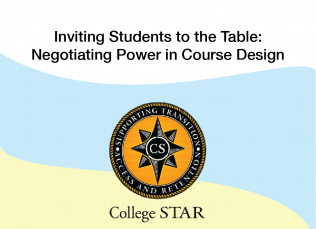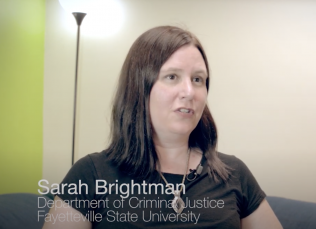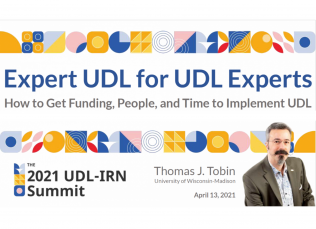
Inviting Students to the Table: Negotiating Power in Course Design
Aligned with adult education theories, enacting democratic practice can have a positive impact on student learning and engagement. In this case study, I explore the role of power in curriculum and course design through considering approaches to involving students in the planning process.
This resource was originally developed with resources from the College STAR grant. That grant has ended and the College STAR modules will now permanently reside at the East Carolina University Office for Faculty Excellence.
Module Introduction
Aligned with adult education theories, enacting democratic practice can have a positive impact on student learning and engagement. Cervero and Wilson (2006) emphasize the role of power in the process of planning educational programs for adult learners; they theorize that the four key dimensions of the “planning table” at play are these: power relations, interests, ethical commitments, and negotiation. This is particularly important in higher education, where the teacher-student relationship is structured such that the teacher holds the power to assign grades and typically the teacher makes planning decisions prior to the course even starting. Putting theory into practice, each dimension can be considered as teachers plan for activities and assignments, course policies, course content, and student evaluation (Weimer, 2013). Educators have experimented with efforts to return power to students by collaborating with them in a range of higher education projects, such as the design of a cohort-based graduate degree program (Colin & Heaney, 2001), pre-service teacher education curriculum development (Enright et al., 2017) and redesign of a first-year undergraduate science course (Bengtson et al., 2017).
In this case study, I explore the role of power in curriculum and course design through considering approaches to involving students in the planning process. In my own teaching, I involved my students in the design of a new graduate course. Student perspectives on participating in this process were gained through an open-ended survey conducted after the conclusion of the semester. Questions were based on the theoretical framework of Cervero and Wilson (2006) in order to gain insight into the role of the student and teacher in the planning process. Qualitative analysis of student responses was conducted based on the constant comparative method (Lincoln and Guba, 1985) in order to reveal common themes. Additionally, I led a Practice Session at the 2020 Conference on Higher Education Pedagogy in which attendees shared their ideas and strategies. Synthesizing experiences from my own practice and input from workshop participants, I describe strategies for engaging students in the decision-making process and discuss real-world tensions in this work that serve as entry points for further reflection and exploration.
Support for this Module
Original development of this module was made possible by the College STAR (Supporting Transition Access and Retention) initiative. College STAR was a grant-funded project focused on partnering postsecondary educational professionals and students to learn ways for helping postsecondary campuses become more welcoming of students with learning and attention differences. Much of this work was made possible by generous funding from the Oak Foundation.
Organization/Publishers:
Share this resource:
Posted date:
November 11, 2022





